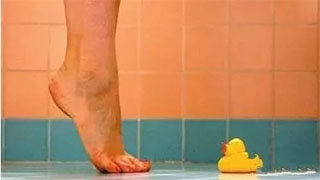
At present, the number of patients with cardiovascular, cerebrovascular, stroke and other diseases in China has exceeded 270 million. Those lazy people who don't exercise for a long time and sit for a long time like farts sticking to their seats will not have their cerebral blood vessels clear and unobstructed. The best way to treat cardiovascular and cerebrovascular diseases is to prevent them early.
Cerebral hemorrhage and stroke mainly lead to hemiplegia, limping, and decreased mobility. And everyone's aging is the result of thinning blood vessels, gradually decreasing blood supply, decreasing brain nutrition, gradually aging, and gradually struggling to walk and becoming old.
Middle aged and elderly people are all afraid of stroke, but a few people know that the simplest action in the world to prevent stroke, dementia, and lower postprandial blood sugar is so simple, just tiptoe.
This is not what ordinary people say about practicing calf muscles or being afraid of getting thicker calves. In addition to the positive effect of exercising the calf muscles and allowing blood vessels to flow in the lower limbs, the brain is able to control the distal paws and belly of the legs, indicating that the nerves are not damaged and the brain is not idle. Stimulating the distal muscle movement will also stimulate the brain, feedback and regulate brain function. The blood vessels inside the decades old skull on the shoulder will not accelerate blockage, so there will be no stroke.
How can I stand on tiptoe?
1. Tiptoe heel
Stand at attention with feet together and hands on both sides of the body.
Slowly stand on tiptoes, grip the ground tightly with your toes, and then drop your weight from your toes to the front soles to relax your body. Finally, perform a free fall motion with the heel lightly colliding with the ground, causing a soft vibration that is then transmitted along both legs to the upper body.
After tiptoeing a few times, you will feel comfortable all over and have an endless aftertaste. You can also find something to assist in maintaining body balance.
If diabetes patients are allowed to stand on their toes slowly, they will naturally consume blood sugar. Severe exercise sometimes increases blood sugar. It is an exercise induced blood sugar increase that keeps pace with the times. Some people suffer from hypoglycemia after exercise, which is a late onset hypoglycemia after exercise. The method to slowly lower blood sugar is actually to stand on tiptoe, don't underestimate it. This is a full body weight load exercise, and when a person weighs, the leg muscles exert a lot of force.
After two years of training, the 85 year old people in our training group have agile legs and improved blood sugar and blood lipids. They no longer believe that drugs can save lives, but believe that only by maintaining good physical fitness can they live long. The movements are super simple, but they need to persevere. Elderly people over 83 years old can also stand on tiptoe while supporting sofas and chairs, laying a solid foundation is necessary for other exercises. But many elderly people have not yet practiced their feet well, their heels are unstable, and their legs are weak, so they tend to run and walk quickly, and some are prone to falling and falling. Let's simply practice tiptoe and hook. (When practicing breathing, stand on tiptoe and inhale slowly as the heel descends. It is best to inhale slowly.) Practice 30 groups per day and 20 groups in segments throughout the day. Persisting in practice can reduce falls and enhance the elderly's confidence in walking.
2. Tiptoe walking
Take 30-50 steps each time, take a short break, and then repeat a few more sets based on your physical condition, with a speed that feels comfortable and relaxed.
The initial practitioner can support the wall, and once proficient, there is no need to rely on external objects.
3. Sitting on tiptoe
Keep your knees and thighs level, and place two mineral water bottles on your thighs for weight-bearing exercises.
Tiptoe 30-50 times each time, with adjustable speed.
4. Lie down and hook your toes
When resting in bed, keep your legs together and extend them straight. Hook and place your toes one by one, and you can do it with both feet or with one foot.
If you feel uncomfortable in your calves, stop and rest. Do 20-30 times each time and adjust the speed on your own.
5. I really don't have time to exercise, and I don't offend anyone by tiptoeing in the office every day. I can practice secretly during meetings. When returning home, it is important to teach the elderly how to stand on tiptoes and hook their feet. Not only can they practice walking muscles, but they can also exercise the brain to prevent dementia. After meals, practicing can also slowly and quietly lower blood sugar
matters needing attention
Tiptoeing should be done step by step, and do not exert too much force, otherwise it can easily lead to heel pain. If it causes pain, rest for a few days, soak your feet in hot water, and it will be okay soon.
When playing chess, cards, playing computer games, or standing still for a long time, it is best to do tiptoe exercises every hour or so to ensure smooth blood flow in the lower limbs and avoid numbness caused by sitting for too long.
Tiptoe is the farthest muscle control and strength training, the simplest and most reliable. Lazy people who sit in the office for a long time, for the sake of your brain health, move your feet! Elderly people, in order to slow down brain aging, please try moving.


